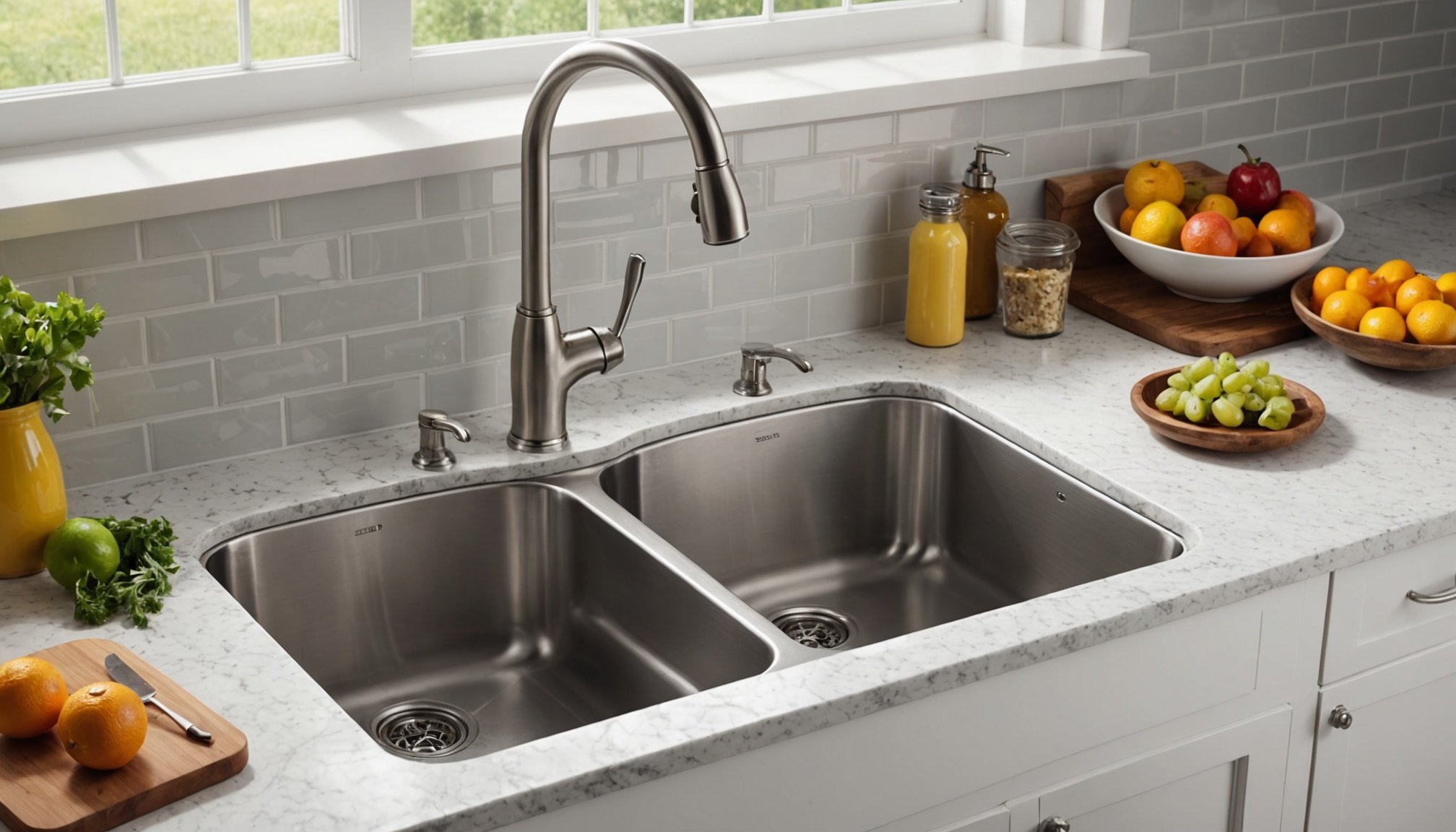Composite Sinks
Composite sinks are crafted from a blend of materials, typically granite or quartz combined with resin. This unique composition ensures that they are not only robust but also resistant to scratches and stains. An important aspect of choosing composite sinks is their noteworthy durability, making them a preferred choice for homeowners seeking longevity and resilience in their kitchen fixtures.
Compared to other types of sinks, composite sinks offer a wealth of advantages. Their non-porous surface ensures that they remain impervious to bacterial growth, while their natural sound-dampening qualities make the kitchen a quieter environment during meal preparation. Additionally, they come in various colours and finishes, offering aesthetic flexibility.
Also read : Master Your Culinary Schedule: The Definitive Guide to Selecting User-Friendly and Precise Kitchen Timers
However, it’s crucial to keep in mind the potential cons. Composite sinks can be heavy and may require additional support during installation. Furthermore, while generally stain-resistant, strong chemicals can occasionally mar their finish. To ensure their longevity, it is advisable to avoid harsh cleaning agents and instead opt for soft cloths and mild dishwashing solutions. Regular maintenance, paired with appropriate cleaning techniques, will help keep your composite sink looking pristine and ensure its function for years to come.
Overview of Kitchen Sink Materials
Choosing the right kitchen sink material is pivotal for both aesthetics and functionality. The various types of sinks available each offer unique benefits and drawbacks that directly impact the longevity and efficiency of your kitchen workspace.
In the same genre : How to Select the Ideal Ice Machine for Your Home Bar: An In-Depth Guide
Commonly used kitchen sink materials include stainless steel, composite, cast iron, fireclay, and copper. Each material boasts different attributes affecting durability, maintenance, and overall appeal. For example, stainless steel is renowned for its resilience against rust and staining, while composite sinks emphasize scratch-resistant surfaces. Cast iron sinks offer distinctive finish options with excellent heat resistance. Fireclay stands out for its scratch resistance and sleek design, whereas copper introduces natural antimicrobial properties and a captivating patina that evolves over time.
The choice of sink materials critically influences kitchen atmosphere, seamlessly integrating with existing decor. While stainless steel delivers a contemporary look, fireclay attracts those opting for a traditional style. Practicality is another consideration; stainless steel promises ease of maintenance, composite handles wear and tear of frequent use, and fireclay requires regular attention to retain its pristine appearance.
In making an informed decision, weigh the durability, upkeep requirements, and how a sink aligns with your kitchen style, ensuring it complements your needs effectively.
Copper Sinks
Copper sinks are celebrated for their natural antimicrobial properties, making them a hygienic choice for your kitchen. These sinks naturally eliminate a vast majority of bacteria on their surface, significantly benefiting those conscious about kitchen cleanliness. This unique feature of copper provides a constant level of hygiene, simplifying maintenance and reducing reliance on chemical cleaners.
In addition to their health benefits, copper sinks develop a patina over time. This gradual change in surface colouration offers a visually striking transformation, creating an evolving aesthetic. The patina process protects the copper, enhancing its resilience and preserving its natural beauty. It’s essential to appreciate this characteristic, as it adds a dynamic charm and warmth to your kitchen’s design.
Maintaining copper sinks requires understanding their sensitivity to certain substances. Avoid abrasive cleaners or harsh chemicals, as these can disrupt the patina. Instead, opt for gentle cleaning solutions and soft cloths. Regular cleaning with mild soap and water preserves their distinctive look and function.
In summary, copper sinks offer a blend of antimicrobial benefits and natural elegance. They require thoughtful care to retain their allure, making them a captivating and practical option for many kitchens.
Cast Iron Sinks
Cast iron sinks are well-regarded for their robust heat resistance and customizable finish options. They are coated with a layer of porcelain enamel, lending a glossy, smooth surface that is both durable and visually appealing. This enamel coating allows homeowners to select from a wide array of colours, ensuring the sink harmoniously complements the kitchen’s design.
The durability of cast iron sinks is another key advantage. These sinks withstand daily wear and tear, maintaining their appearance for many years. Their heavyweight nature, however, necessitates reinforced support during installation, which is crucial to prevent damage to surrounding countertops or cabinetry.
Caring for cast iron sinks involves careful maintenance to preserve their lustre and function. It’s advisable to avoid abrasive cleaners, as these can erode the enamel finish over time. Instead, gentle dishwashing soaps and soft cleaning cloths should be used. For stubborn stains, a paste of baking soda and water can be effective without harming the surface.
In summary, cast iron sinks offer a balance of style and functionality, standing out with their attractive enamel finishes and long-term resilience. Proper maintenance is essential to protect their finish, ensuring these sinks remain a stylish centrepiece in any kitchen.
Stainless Steel Sinks
Stainless steel sinks are highly regarded in kitchen design due to their exceptional durability and resistance to rust and staining. Their robust nature allows them to withstand daily wear and tear without losing their functionality or aesthetic appeal. These sinks are also non-porous, which contributes to their outstanding resistance against bacteria and makes them easier to maintain.
One of the primary advantages of stainless steel sinks is their ease of maintenance. They can be cleaned using mild detergents and soft cloths, ensuring they remain hygienic with minimal effort. This attribute is particularly beneficial in busy kitchens where hygiene and efficiency are paramount.
In terms of aesthetics, stainless steel offers versatility. It complements a wide array of kitchen styles, from modern minimalism to traditional elegance. The reflective surface of these sinks can help brighten up the kitchen and match various countertop materials seamlessly.
However, potential downsides include noise from water impact and the possibility of scratches. These minor drawbacks can be mitigated by using a sink mat or choosing a model with sound-dampening features. Overall, stainless steel sinks provide a balance of practicality, durability and style, making them a popular choice for many homeowners.
Maintenance and Care Tips
Regular sink maintenance is crucial to ensuring longevity and aesthetic appeal. Understanding the specific needs of your sink’s material is the first step. Using mild dishwashing liquid and a soft cloth is advisable across all types of sinks for daily cleaning. This helps in removing grime without causing abrasions.
For stainless steel sinks, avoiding abrasive cleaners or scouring pads is essential as they can damage the surface. Opt for a mixture of vinegar and water to tackle water spots effectively. Composite sinks, while durable, are best maintained with mild detergents, avoiding bleach-based cleaners to preserve their finish. For specific spots, employing a soft-bristle brush can be beneficial.
Cast iron and fireclay sinks should not face harsh chemicals; a paste of baking soda and water offers a gentle scrub. Attention must be given to the edges where grime accumulates.
Copper sinks require special attention to maintain their patina. Avoid chemicals that could strip this protective layer. Instead, utilize warm water and a pH-balanced soap for cleaning. The patina enhances over time, creating a unique aesthetic.
For all materials, incorporating protective mats or grids will reduce the impact of heavy cookware, preserving your sink for years to come.
Fireclay Sinks
Fireclay sinks are an appealing option, known for their remarkable scratch resistance and stylish design. Their construction involves clay being shaped and fired at high temperatures, resulting in a durable surface that can withstand vigorous daily use. These sinks do not easily chip or crack, providing longevity that homeowners find advantageous.
The aesthetics of fireclay sinks are unparalleled, offering a classic yet lavish look often compared to ceramic materials. Fireclay’s non-porous nature makes it less susceptible to staining and easier to maintain than many ceramic alternatives. This quality enhances its suitability for traditional kitchen styles and luxurious modern designs.
When it comes to maintenance, fireclay sinks are relatively straightforward to care for. Regular cleaning with mild dish soap and a soft cloth is sufficient to keep them sparkling. Extreme temperatures should be avoided to prevent stress on the material, while abrasive cleaners should also be sidestepped to preserve its lustrous finish.
Their unique properties make fireclay sinks a robust and visually appealing choice for many kitchens. They offer practicality without compromising on style, proving to be a favourite for those who appreciate a blend of elegance and resilience in their kitchen fixtures.
Final Recommendations
Selecting the right kitchen sink materials is a pivotal step in ensuring both functionality and style in your kitchen renovation. Choosing the appropriate material can significantly influence the overall kitchen aesthetic and its practical utility. For instance, a contemporary kitchen may benefit from the sleek look of stainless steel, while a rustic design could be enhanced by the warm appeal of copper sinks.
When investing in a new sink, consider elements such as durability, maintenance needs, and how each material aligns with your kitchen preferences. Materials like composite sinks offer a balance of durability and design versatility, making them suitable for diverse kitchens. Alternatively, fireclay sinks bring unparalleled style and scratch resistance.
Tips for a successful sink purchase include evaluating the sink’s role in your daily kitchen activities and how it complements other fixtures. Consider the longevity and maintenance aspects to ensure your sink remains a centrepiece for years to come. Price point and material quality should also be factored in before making a final decision.
For reliable guidance, researching trusted brands known for quality and innovation can further contribute to a satisfactory purchasing experience. This wise approach ensures your kitchen sink not only meets your immediate needs but also enhances your home’s overall charm and functionality.
Comparative Analysis of Kitchen Sink Materials
Understanding the sink material comparison is crucial when selecting the right fixture for your kitchen. Different types of sinks vary significantly in terms of durability, maintenance, and cost-effectiveness. Let’s delve into these aspects to aid your decision-making process.
Durability is a primary concern. Stainless steel sinks are renowned for their resilience against rust and wear, positioning them as a reliable choice for high-traffic kitchens. Conversely, cast iron sinks boast long-term durability with their enamel finish, offering heat resistance and strength. Fireclay sinks bring robust scratch resistance to the table, making them ideal for homes valuing both style and sturdiness.
Maintenance considerations follow closely. Stainless steel is low-maintenance, needing only mild detergents for cleaning, while composite sinks, although scratch-resistant, require gentle handling to preserve their finish. Fireclay requires somewhat less upkeep compared to ceramic, maintaining its elegance with simple cleaning routines.
Cost-effectiveness varies with sink materials. Stainless steel often presents a budget-friendly option, whereas copper and fireclay might demand a higher initial investment but offer unique benefits like antimicrobial properties and unmatched aesthetics.
Seek a material that aligns seamlessly with your kitchen’s needs, ensuring both functionality and aesthetic satisfaction. A visual chart comparing these factors can further streamline selection, ensuring you choose the optimal kitchen sink material.











